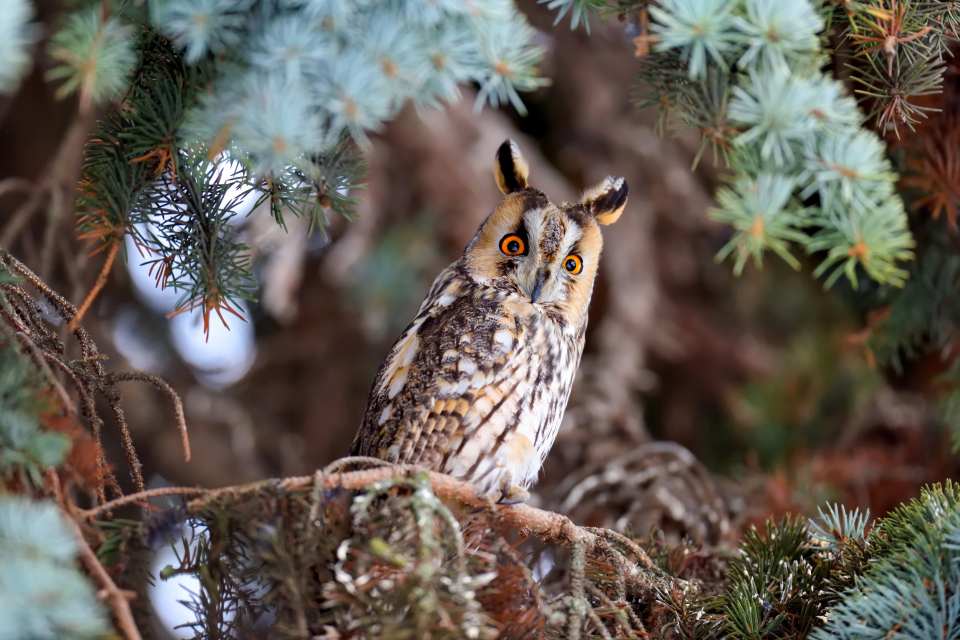Species Guide: Snowy Owl (Bubo scandiacus, formerly Nyctea scandiaca)
Family: Strigidae
The Snowy Owl is one of the most iconic Arctic birds: large, white, and highly adapted to life on the tundra. It’s circumpolar in distribution (found across the Arctic regions of North America, Europe and Asia), nomadic in winter, and famous for occasional mass southward movements called irruptions. Snowy Owls are powerful diurnal hunters (often active by day), and their striking white plumage has made them a fixture in culture and nature writing.
Appearance
Snowy Owls are very large, bulky owls with round heads (ear tufts are typically absent or tiny), bright yellow eyes, and heavily feathered legs and toes for insulation. Plumage ranges from almost pure white to heavily barred dark patterns.
Male: Adult males tend to be paler than females and often become nearly pure white with age. The whitest individuals are usually males.

Female: Females generally retain more dark barring throughout life, appearing salt-and-pepper or heavily spotted compared with males. Females are also typically larger on average.

Juvenile: Juveniles (of both sexes) typically exhibit dense, dark barring and spotting, which helps camouflage them on the tundra; this pattern lightens as they mature (males more noticeably so). Juveniles can look very streaked compared with adults.

Diet
Snowy Owls are carnivores and opportunistic predators. Their primary food in the Arctic is small rodents, especially lemmings (genera Lemmus and Dicrostonyx) and voles, often taking large numbers when those populations peak. When lemmings are scarce or elsewhere in their range, they will take a broad diet: rabbits and hares, other mammals (ground squirrels, voles), a wide variety of birds (ducks, geese, shorebirds, sometimes passerines), fish, and carrion. In some coastal or agricultural wintering areas, they switch to birds and human-associated rodents (e.g., rats).
Habitat
Snowy Owls breed on treeless Arctic tundra, open, flat or rolling landscapes where visibility is high (they often nest on slight rises). On wintering grounds, they seek similarly open terrain: coastal dunes, agricultural fields, grasslands, airport fields, and sometimes urban waterfronts or islands. They prefer open views for hunting and will perch on low posts, hay bales, or the ground. Their nomadic tendencies are closely tied to the availability of prey.
Non Breeding
Breeding
Behavior
Daily activity & hunting: Unlike many owls, Snowy Owls are frequently active during daylight (especially in Arctic summer). They hunt from low perches or the ground, scanning for prey and then flying low to capture it. When prey is abundant, parents may provision nests with large caches.
Irruptions / movement: Snowy Owl movements are strongly influenced by prey cycles (lemming booms and busts). Years of excellent breeding success (often tied to lemming abundance) can produce large numbers of juveniles that move south in winter; these are the famous irruptions. Conversely, poor prey years keep birds closer to the Arctic or reduce breeding output.
Calls / vocalisations: Vocal repertoire includes deep, resonant hoots and barks (males especially produce territorial hoots in breeding season), harsh hisses and bill-snapping when threatened, and high-pitched whistles or squeals from young. They are generally less vocal than many forest owls but can be quite loquacious near nests.
Life cycle / breeding: Snowy Owls nest on ground scrapes in tundra. Breeding is highly variable: clutch size ranges widely (commonly 3–11 eggs, sometimes more) and tracks prey abundance; large lemming years produce larger clutches. Incubation (~30–34 days) is mainly by the female, and chicks hatch asynchronously. Both parents may feed chicks; fledging occurs several weeks later, and juveniles may remain dependent for some time. Longevity in the wild varies; average lifespans are around a decade in many records, but individuals can live longer.
Biometrics
Typical measurements (both sexes combined, ranges reported by major bird references):
- Length: ~52–71 cm (20.5–27.9 in).
- Wingspan: ~126–145 cm (49.6–57.1 in).
- Weight: commonly ~1.6–2.95 kg (56.4–104.1 oz), with females generally heavier than males.
Females are on average larger and heavier (reverse sexual dimorphism common in raptors). These figures vary by region and season (winter birds can weigh more when prey is abundant).
Natural Predators
Adult Snowy Owls, because of their size and strength, have relatively few predators. Threats come mainly from:
- Other raptors: occasional attacks by larger eagles or Great Horned Owls in some regions.
- Mammalian predators: Arctic foxes, wolves, or wolverines may take eggs or young at nests if parents are absent or using caches to store prey.
- Humankind / anthropogenic threats: collisions (vehicles, fences, power lines), exposure to contaminants, and persecution historically (now mostly illegal/protected). Eggs and young are most vulnerable to predation.
Relationship to Humans
Snowy Owls have a long cultural presence: to Arctic peoples, they are part of traditional knowledge and folklore; in Western traditions, owls generally symbolise wisdom and mystery. The Snowy Owl achieved modern cultural fame as “Hedwig” in the Harry Potter series, reinforcing popular fascination. Museums and natural history collections (and artists, writers and photographers) have long celebrated them. Traditional fables often emphasise the owl’s watchfulness, cold-climate resilience, and ghostly, silent flight; accounts differ across cultures (from respect and reverence to superstitions). Human impacts include historical hunting and collection, modern disturbance from photography and tourism (which can stress nesting adults), and both positive interest (birdwatching) and negative interactions (collisions, secondary poisoning).
Conservation Status
The Snowy Owl has been assessed as Vulnerable on some conservation lists and has shown substantial declines in parts of its range. Multiple monitoring efforts report long-term population decreases linked primarily to climate change (which affects tundra ecosystems and lemming cycles), habitat alterations, and human-caused threats at wintering sites. Estimates and trends vary regionally; some winter counts show dramatic year-to-year variation because of irruptive behavior, but long-term analyses point to significant overall declines.
Global
Conservation Status

Related Articles






Ad Space
References
- Lovette, I. et al. (2016) The Cornell Lab of Ornithology, handbook of bird biology. Third edition. Chichester: Wiley. [Accessed 19/11/2025]
CITATIONS
- By Own work using: www.iucnredlist.org, CC BY-SA 3.0, [Accessed 19/11/2025] ↩︎








